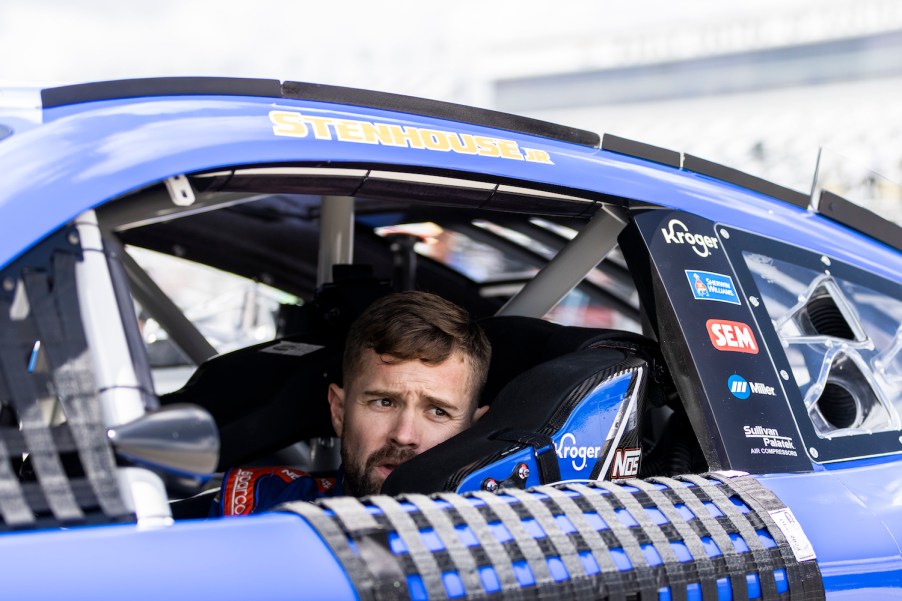
NASCAR’s Next Gen Cars Are Too Hot To Drive
NASCAR is unveiling the brand new Next Gen race car for the 2022 season. Several drivers have taken this spec chassis out for test races. Responses vary, but everyone agrees the interior of the new car is too hot to race.
For NASCAR Next Gen, heat is a ‘big, big concern’

For the 2021 season, NASCAR is still using the sixth-generation of its stock car race car. But for over two years, NASCAR engineers have been redesigning the vehicle for the Next Gen racecar.
Several NASCAR teams have begun testing the new car. In September 2021, eight teams ran a tire and drafting dynamics test at Daytona International Speedway. After a weekend of testing, drivers had complaints. It is now clear just how hot–and dangerous–the Next Gen cockpit is.
Owner-driver Denny Hamlin said, “I can’t express how hot it was.” He added, “It’s a big, big concern, obviously. It’s difficult because it’s the way the car is designed…I think you’re gonna have to really make some big changes to it, something that will allow us to finish races without having major issues.”
The exhaust heats up the Next Gen car’s floor

The New NASCAR race car will use the same V8 as the outgoing sixth-gen model. But the manifold and exhaust will be very different. The 2021 race cars featured a right-side exhaust exit. The new NASCAR cars will have left and right manifolds and downpipes, with twin exhaust pipes running through boxed channels under both sides of the car, then exiting in front of both rear wheels.
Autosports fans watching race track testing say the new cars sound great. Drivers note that the car’s audio cues are similar enough to what they are used to. But the new exhaust system has one major problem: the heat.
Each boxed channel beneath the floor of the car reaches 450 degrees. Worse yet, the left-side channel runs directly under the driver’s seat. The Next Gen driver’s seat is even mounted closer to the floor than in the previous car. The result is a very hot floorplan and a dangerously hot cockpit.
The hood-top vents bake the windshield

The engineers at NASCAR designed the Next Gen car to create as much downforce as possible. They leveraged a full car-length underwing with a diffuser, a stepped splitter, and a new spoiler design. In addition, they reinvented the engine’s air intake.
The Next Gen car breathes through a grille set low in the nose. This air flows through the radiator to cool the engine. After the radiator, the hot air is expelled out of two vents on the car’s hood. The new air path adds to the downforce the Next Gen car creates.
The aerodynamics of the Next Gen car will have two major benefits for NASCAR. Firstly, the Next Gen car will handle very well. Chris Buescher said, “The steering is way quicker than anything I’ve ever driven.” The new car’s steering is so quick, teams are trying to reduce the car’s responsiveness.
In addition, the Next Gen cars do not create as much turbulence. For this reason, they should be easier to pass. NASCAR President Steve Phelps predicted, “I think the racing is going to be better based on the aerodynamics of the vehicle.”
The Aerodynamics of the Next Gen car has one major drawback. The hood-top vents eject hot air directly at the car’s windshield. This curtain of hot air makes the Next Gen race car’s cabin even hotter.
Cooling down NASCAR’s Next Gen car

The officials at NASCAR understand that the cabin of the Next Gen car is too hot. The Senior Vice President of Racing Innovation, John Probst admitted, “We have to work on the heat in the car.” Probst is optimistic that a solution exists, adding, “We have some ideas there.”
What will NASCAR do to cool down the Next Gen cars? One option would be to return to a right-side exhaust system with a single exit. Unfortunately, the hood-top air vents will prove a more complex engineering challenge.
The Australian Supercar Championship features a race car very similar to the NASCAR Next Gen spec car. The Australian Supercars also use a hood-top vent to increase downforce. The teams racing these tried-and-true Australian cars must also keep their drivers cool. One method in Australia is a cooling suit for the driver. We will see if NASCAR implements the same gear.
In the meantime, the NASCAR teams testing their new Next Gen cars are finding creative solutions to reduce the cabin temperature. After testing the car, Chris Buescher said, “We’re working on trying to cool it off. We’ve got some different hose configurations, so we’re going through those trying to alleviate some of the heat inside.”
One of these hose configurations is visible in Buescher’s in-car footage from the recent Next Gen Goodyear tire test at Daytona International Speedway. The vent system includes at least two hoses plumbed from the passenger window and delivering air to the driver.
We hope the engineers find a solution to cool the Next Gen cars so we can enjoy a fast, and safe, 2022 NASCAR Cup season.



